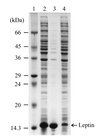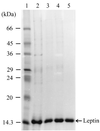High-level production of human leptin by fed-batch cultivation of recombinant Escherichia coli and its purification
- PMID: 10388699
- PMCID: PMC91452
- DOI: 10.1128/AEM.65.7.3027-3032.1999
High-level production of human leptin by fed-batch cultivation of recombinant Escherichia coli and its purification
Abstract
Human leptin is a 16-kDa (146-amino-acid) protein that is secreted from adipocytes and influences body weight homeostasis. In order to obtain high-level production of leptin, the human obese gene coding for leptin was expressed in Escherichia coli BL21(DE3) under the strong inducible T7 promoter. The recombinant leptin was produced as inclusion bodies in E. coli, and the recombinant leptin content was as high as 54% of the total protein content. For production of recombinant human leptin in large amounts, pH-stat fed-batch cultures were grown. Expression of leptin was induced at three different cell optical densities at 600 nm (OD600), 30, 90, and 140. When cells were induced at an OD600 of 90, the amount of leptin produced was 9.7 g/liter (37% of the total protein). After simple purification steps consisting of inclusion body isolation, denaturation and refolding, and anion-exchange chromatography, 144.9 mg of leptin that was more than 90% pure was obtained from a 50-ml culture, and the recovery yield was 41.1%.
Figures






Similar articles
-
Production of tilapia insulin-like growth factor-2 in high cell density cultures of recombinant Escherichia coli.J Biotechnol. 2004 Jan 22;107(2):161-71. doi: 10.1016/j.jbiotec.2003.09.014. J Biotechnol. 2004. PMID: 14711499
-
Secretory production of human leptin in Escherichia coli.Biotechnol Bioeng. 2000 Feb 20;67(4):398-407. Biotechnol Bioeng. 2000. PMID: 10620755
-
Bioprocessing of therapeutic proteins from the inclusion bodies of Escherichia coli.Adv Biochem Eng Biotechnol. 2003;85:43-93. doi: 10.1007/3-540-36466-8_3. Adv Biochem Eng Biotechnol. 2003. PMID: 12930093 Review.
-
Enhanced production of human mini-proinsulin in fed-batch cultures at high cell density of Escherichia coli BL21(DE3)[pET-3aT2M2].Biotechnol Prog. 1997 May-Jun;13(3):249-57. doi: 10.1021/bp970018m. Biotechnol Prog. 1997. PMID: 9190075
-
Expression, Solubilization, Refolding and Final Purification of Recombinant Proteins as Expressed in the form of "Classical Inclusion Bodies" in E. coli.Protein Pept Lett. 2021;28(2):122-130. doi: 10.2174/0929866527999200729182831. Protein Pept Lett. 2021. PMID: 32729411 Review.
Cited by
-
Production of Enantiopure Chiral Epoxides with E. coli Expressing Styrene Monooxygenase.Molecules. 2021 Mar 10;26(6):1514. doi: 10.3390/molecules26061514. Molecules. 2021. PMID: 33802034 Free PMC article.
-
Increasing recombinant protein production in Escherichia coli through metabolic and genetic engineering.J Ind Microbiol Biotechnol. 2011 Dec;38(12):1891-910. doi: 10.1007/s10295-011-1034-4. Epub 2011 Sep 8. J Ind Microbiol Biotechnol. 2011. PMID: 21901404 Review.
-
Recombinant production of medium- to large-sized peptides in Escherichia coli using a cleavable self-aggregating tag.Microb Cell Fact. 2016 Aug 5;15(1):136. doi: 10.1186/s12934-016-0534-3. Microb Cell Fact. 2016. PMID: 27495238 Free PMC article.
-
Current state and recent advances in biopharmaceutical production in Escherichia coli, yeasts and mammalian cells.J Ind Microbiol Biotechnol. 2013 Apr;40(3-4):257-74. doi: 10.1007/s10295-013-1235-0. Epub 2013 Feb 6. J Ind Microbiol Biotechnol. 2013. PMID: 23385853 Review.
-
In vivo production of a novel glycoconjugate vaccine against Shigella flexneri 2a in recombinant Escherichia coli: identification of stimulating factors for in vivo glycosylation.Microb Cell Fact. 2015 Jan 23;14:12. doi: 10.1186/s12934-015-0195-7. Microb Cell Fact. 2015. PMID: 25612741 Free PMC article.
References
-
- Altmann S W, Timans J C, Rock F L, Bazan J F, Kastelein R A. Expression and purification of a synthetic human obese gene product. Protein Express Purif. 1995;6:722–726. - PubMed
-
- Campfield L A, Smith F J, Guisez Y, Devos R, Burn P. Recombinant mouse OB protein: evidence for a peripheral signal linking adiposity and central neutral networks. Science. 1995;269:546–549. - PubMed
-
- Cohen S L, Halaas J L, Friedman J M, Chait B T, Bennett L, Chang D, Hecht R, Collins F. Human leptin characterization. Nature. 1996;382:589. - PubMed
-
- Curless C, Pope J, Tsai L. Effect of preinduction specific growth rate on recombinant alpha consensus interferon synthesis in Escherichia coli. Biotechnol Prog. 1990;6:149–152. - PubMed
-
- Fass R, van de Walle M, Shiloach A, Joslyn A, Kaufman J, Shiloach J. Use of high density cultures of Escherichia coli for high level production of recombinant Pseudomonas aeruginosa exotoxin A. Appl Microbiol Biotechnol. 1991;36:65–69. - PubMed
Publication types
MeSH terms
Substances
LinkOut - more resources
Full Text Sources
Other Literature Sources

